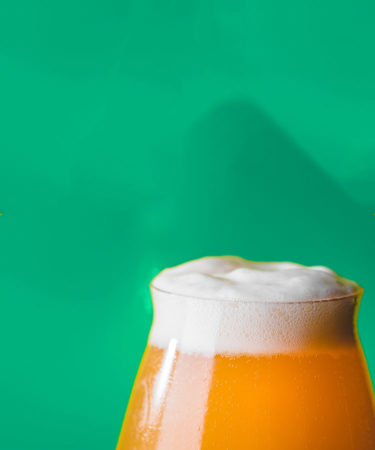Few things in this world command hours-long lines, truck-chasing juice wolves, internet economies, and endless debates quite like juicy and hazy IPAs. Commercially known as New England-style IPAs, or NEIPAs for short, these beers are booming.
According to IRI Worldwide, from July 2017 to July 2018 the style grew more than 200 percent in dollar sales, and sales by volume were up 50 percent. At the Great American Beer Festival this year, held Sept. 20 to 22 in Denver, contest entries for American-style IPA were outnumbered for the first time ever by a Brewers Association newcomer: Juicy or Hazy IPAs.
No longer written off as a fad, NEIPAs are here to stay. If your understanding of the style is a little, well, cloudy, you’re not alone. Here are six questions you might have about NEIPAs, answered.
1. Are NEIPAs from New England?
Yes and no. The nascent style traces back to New England, where brewers like the Alchemist and Hill Farmstead in Vermont, and later Tree House and Trillium in Massachusetts, introduced hopped-up, hazy IPAs to the marketplace.
Now, however, NEIPAs are produced all over, from tiny taprooms in Texas, to nationally distributed craft brands like New Belgium and Samuel Adams, to other continents like Europe and Asia.
In fact, New Belgium’s Voodoo Ranger Juicy Haze and Boston Beer’s Samuel Adams New England IPA claim the top two performing NEIPA brands of the year.
2. What makes NEIPAs “juicy”?
NEIPAs are called “juicy” or “juice bombs” because they literally taste, smell, and look like juice. Hops are added late in the brewing process, as well as during primary and secondary fermentation, which enables brewers to coax out fruity aromas like passion fruit, peach, and mango with little perceivable bitterness on the palate, so they go down sweet and easy.
NEIPAs can also be visually indistinguishable from a glass of orange or mango juice because of their bright yellow color, thick texture, and low carbonation.
3. How are NEIPAs different from regular IPAs?
As silly as it may sound, NEIPAs are different from IPAs in pretty much every way. While a regular old IPA is clear orange-gold in appearance, piney and citrusy on the nose, and bitter in flavor, NEIPAs are unfiltered, murky, and yellow. They smell like a fruit basket and have almost no perceptible bitterness. Ingredients vary, but most NEIPAs are made with grains like pale malts, wheat, and oats; adjuncts like lactose; and other additives to boost their creamy mouthfeel and cloudy optics (some brewers even use apple purée!).
NEIPAs are over-the-top hopped like their IPA parents, but in a very different way. Brewers accomplish the tropical aromatics sans astringency by adding lots of hops after the wort is boiled, or during the “whirlpool,” and during primary or secondary fermentation (this is also known as dry-hopping). This way, hops are not exposed to heat, so “juicy” notes abound without any bitterness.
4. Why are NEIPAs so dang popular?
NEIPAs are fetishized for a few reasons. One is, they’re easy and fun to drink, with tropical fruit-forward aromas and flavors that make chugging one akin to gulping down a literal glass of sweet juice.
Secondly, “true” NEIPAs, or those made in small batches at small breweries, are specialty brews that are only available and fresh for a short amount of time. They are ticking time bombs — they’re brewed fast, sell out even faster, and stuffed with so many hops and haze-producing pectins that their flavor could fall off within weeks. This is why you might see something like “drink fresh” printed on the can.
Finally, don’t underestimate the power of photogeneity and Instagram. NEIPAs look cool. In appearance, as in aroma and flavor, they are completely different from other beers — bright yellow and totally opaque, and different from your average fizzy copper brew.
5. What’s a juice wolf?
So glad you asked. Although usually said in jest, “juice wolf” describes a very real beer consumer: the young, enthusiastic broski who hunts down juicy IPAs and will destroy everything in their path to get them. The juice wolf isn’t just waiting in line for the latest NEIPA release; they camped out the night before, already made trades at 7 a.m., and maybe have never tried any other beer style. (See also: juiceboy; hazeboi.) These terms are gendered, but encompass male, female, and gender-non-conforming drinkers.
6. What breweries make the best NEIPAs?
In the sub-style’s region of origin, New England, the most sought-after NEIPA producers include Trillium Brewing in Canton and Boston, Mass.; Tree House Brewing in Monson and Charlton, Mass.; and Bissell Brothers in Portland, Maine.
Some of our favorite other New England-style IPAs are from Kings County Brewers Collective in Brooklyn; The Answer Brewpub in Richmond, Va.; and Monday Night Brewing in Atlanta.
West Coast favorites include WeldWerks Brewing in Greeley, Colo., Monkish Brewing in Torrance, Calif., and Reuben’s Brews in Seattle.
National and regional brands are also producing more widely available attempts at the style. While not quite the same thing as a super-small-batch, turbid brew, VinePair panelists picked these eight beers as our favorites.
